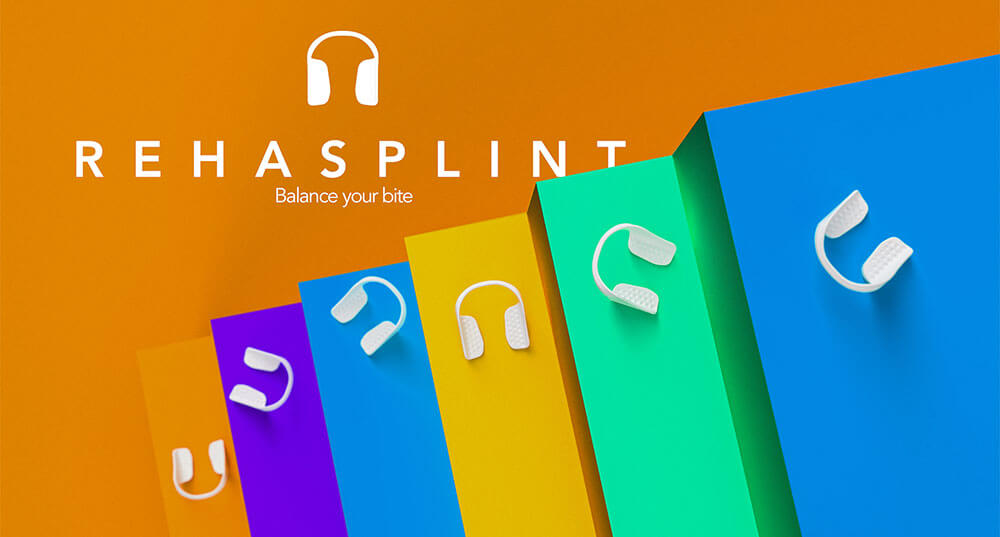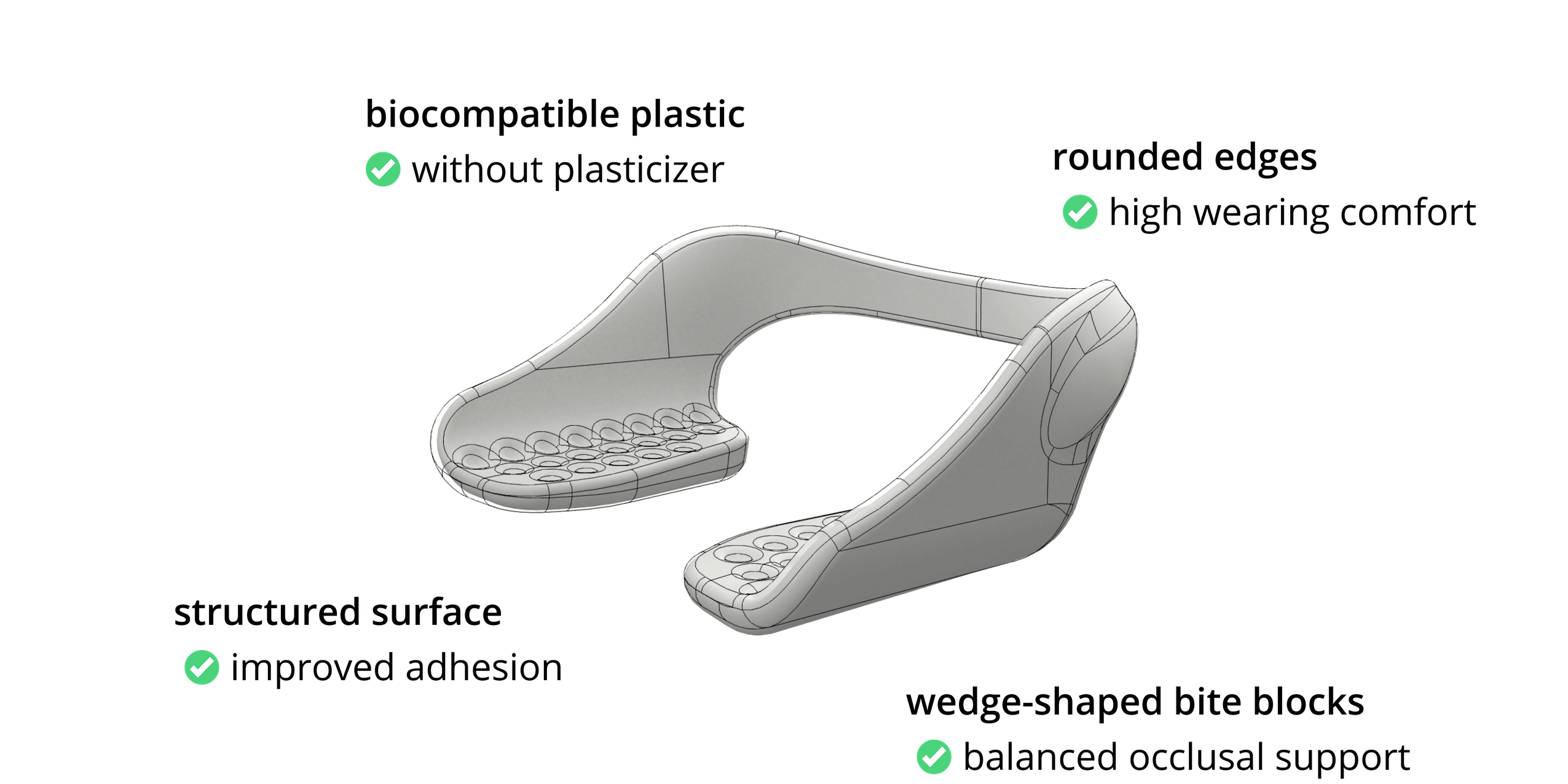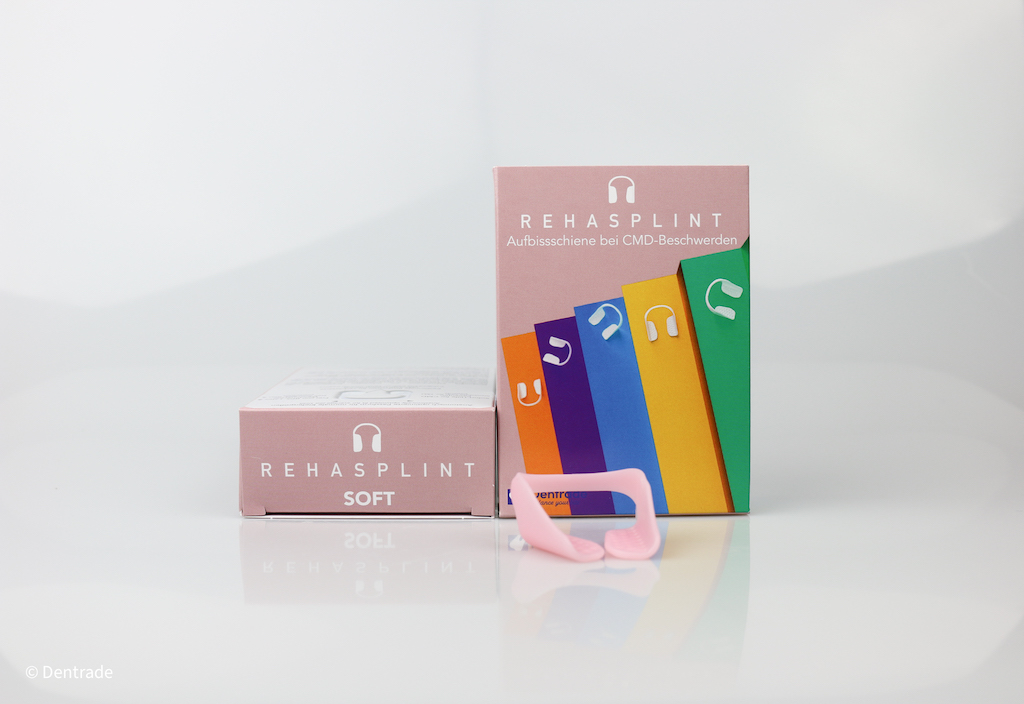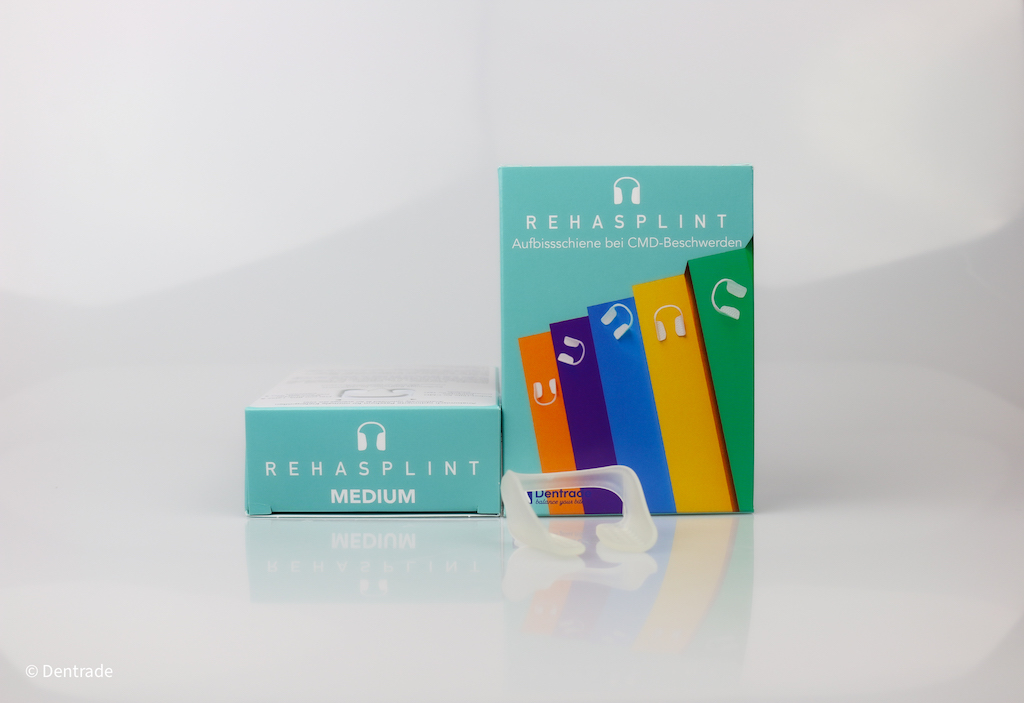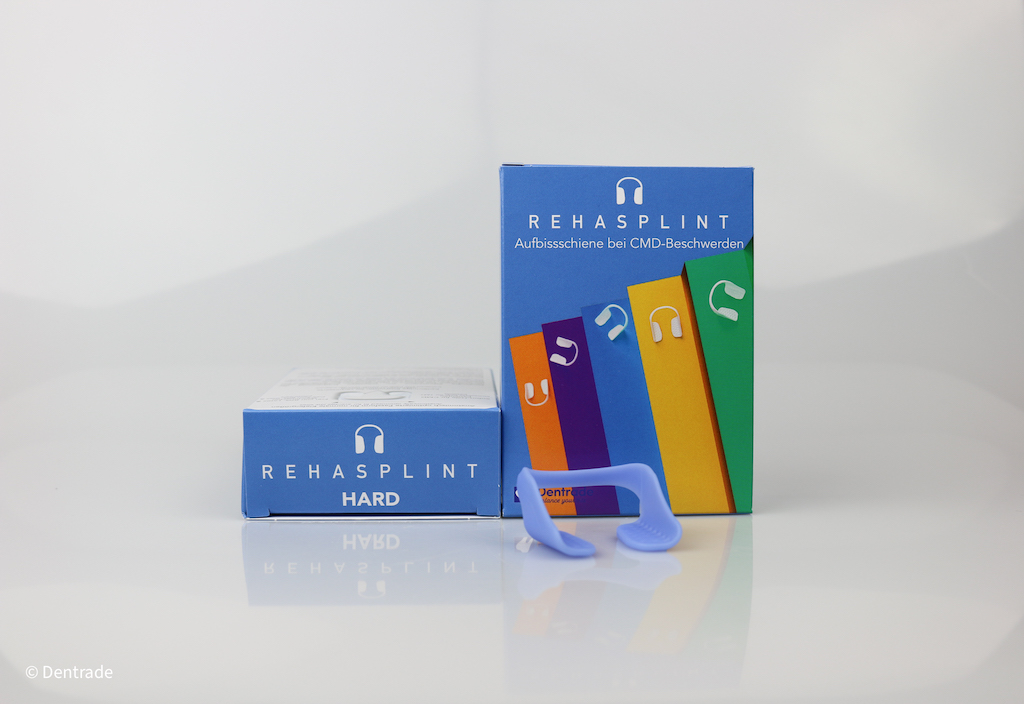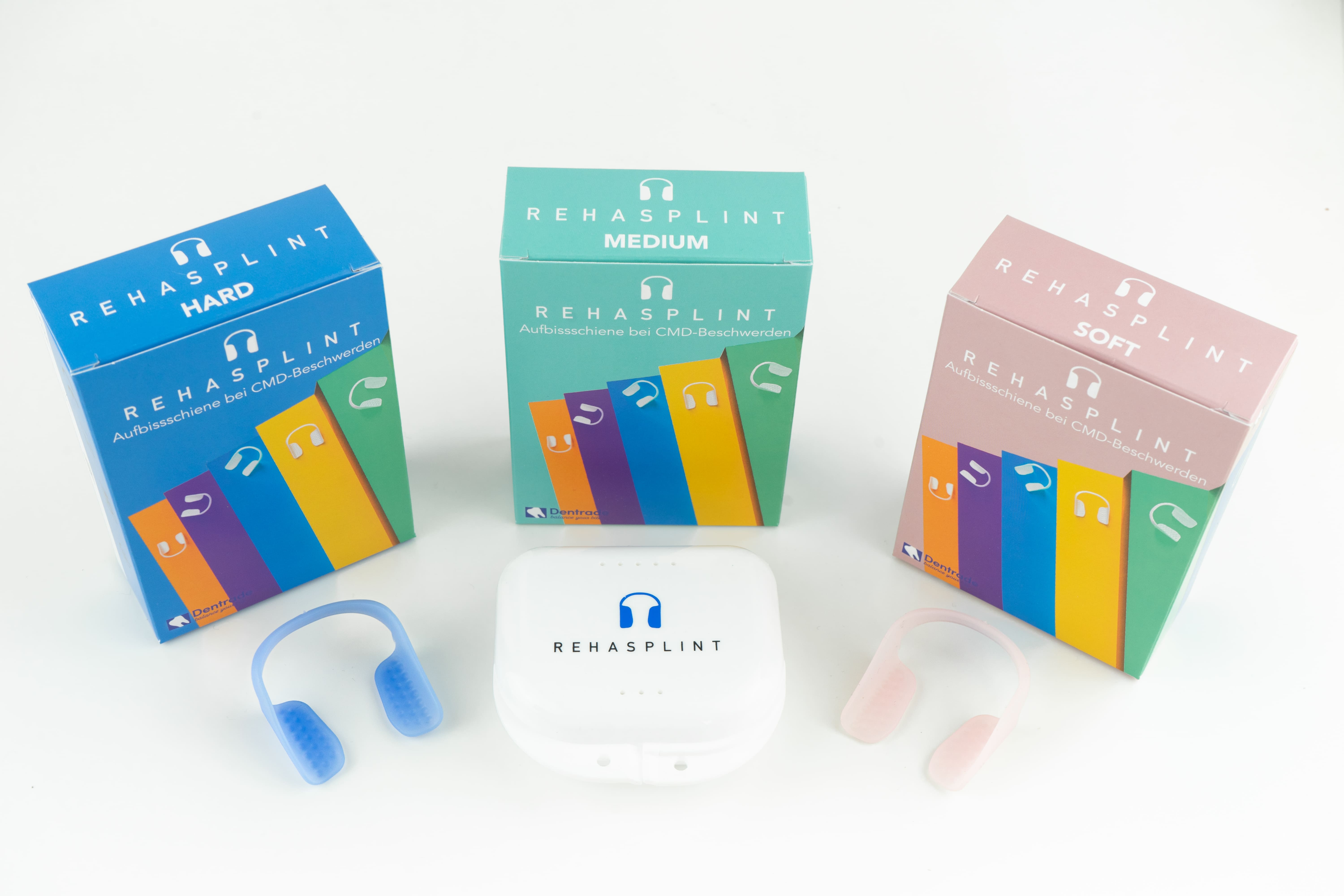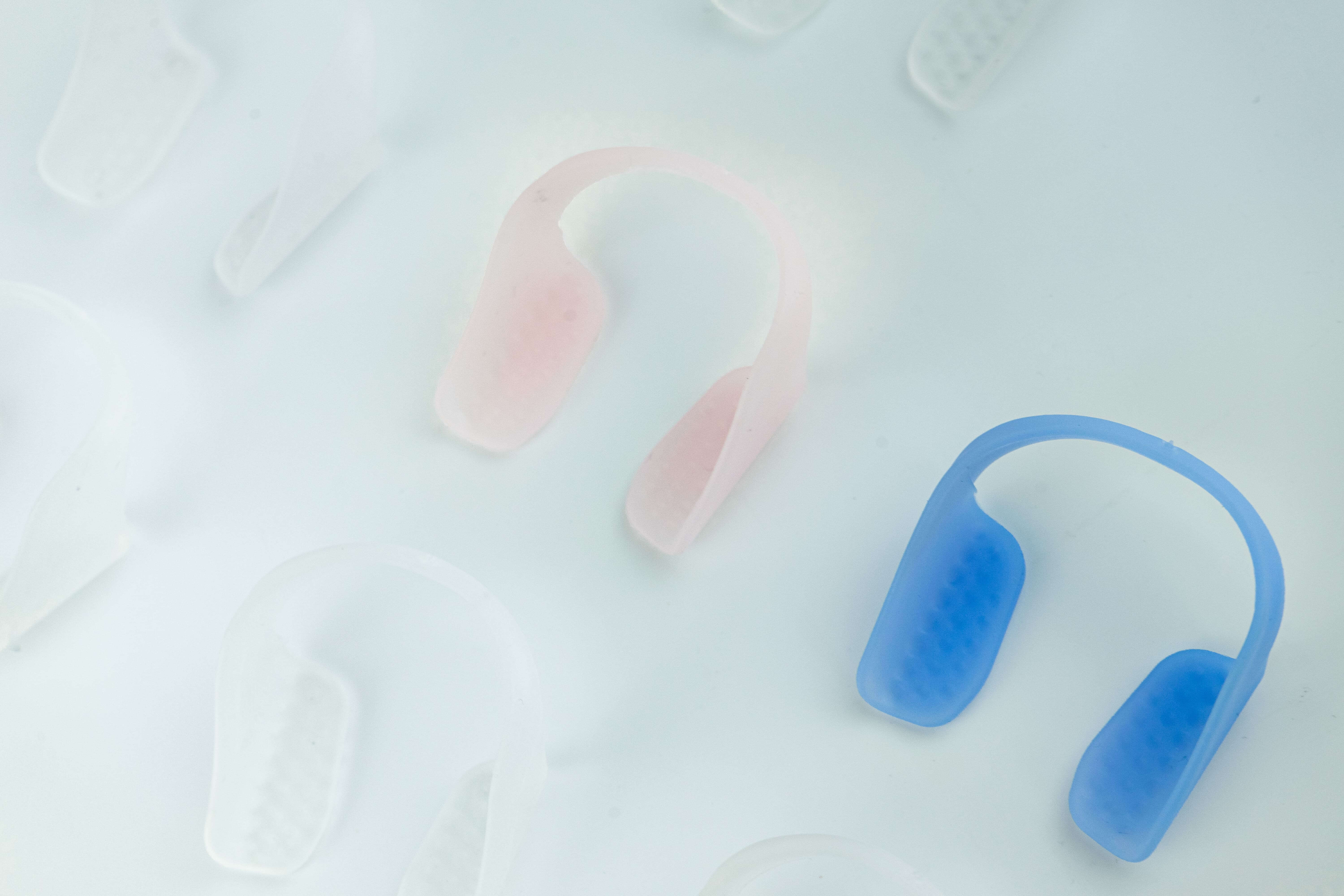Content
- Temporary dental splint: What is the RehaSplint?
- How to use the RehaSplint at home
- For medical professionals
- RehaSplint models: 3 designs
- Alleviating TMD symptoms with the RehaSplint
- Exclusive offers for practitioners
- What our customers say
- RehaSplint, Aqualizer & RehaBite – the differences
- FAQs
Temporary dental splint: What is the RehaSplint?
Reduce your TMD complaints such as teeth grinding and clenching with the RehaSplint – our short-term dental splint for immediate relaxation of the chewing muscles.
The temporary occlusal splint protects your enamel and teeth from pressing, grinding and harmful abrasion. It relieves adapted restraint of your lower jaw or compensates for occlusal early contacts. The splint with the one-size-fits-all design provides temporary and immediate relief from TMD symptoms. It is available in three different hardnesses:
- Soft
- Medium
- Hard
How to use the RehaSplint at home
Using the RehaSplint is easy – you simply insert the splint into your mouth, then lightly bite on the symmetrical pads. Usually, you can apply the TMJ mouth splint right away without any adjustments. If the splint is too long, you can shorten it to your own size. The RehaSplint can be worn both during the day and at night.
For medical professionals
Dentists can use it to prepare a neuromuscular bite registration and also provide their patients with initial treatment for acute pain relief. The slight wedge shape of the bite pads provides adequate support for the dentition during light bite. The material consists of a durable elastomer that can withstand even strong chewing forces.
RehaSplint models: 3 designs
There are three versions of the RehaSplint. These have been developed to meet the needs of different patients due to different physical conditions. The splint is available in 3 Shore hardnesses:
RehaSplint Soft
The soft splint, RehaSplint Soft (≈40 Shore A), is particularly suitable for very sensitive patients.
RehaSplint Medium
The beginner splint, RehaSplint Medium (≈50 Shore A), combines the comfortable feel of a softer splint and the resilience for heavier grinding or pressing.
RehaSplint Hard
The hard splint, RehaSplint Hard (≈60 Shore A) is particularly suitable for severe bruxism.
Especially during orthodontic treatment, the softer and more comfortable material of the RehaSplint is an advantage. If you are prone to bruxism, you should choose a harder material. The splint has no sharp corners or edges and is therefore suitable for sensitive patients.
Depending on the individual clinical picture and physiological conditions, the hardness should be selected.
RehaSplint Soft
The soft splint is particularly suitable for very sensitive patients. You may find the RehaSplint Soft comfortable during the day. For patients who suffer from snoring at night, the soft splint has achieved very good results so far as well.
Teeth are of enormous importance for the entire body, and thus also for performance. Misalignments of the bite, often combined with misalignments of the spine, can restrict mobility, productivity, and performance. Thus, splints and aligners are recommended especially in professional sports and also for Olympic participants who clench their teeth very hard during enormous physical exertion.
The massive pressure on the temporomandibular joints, which can lead to tension in the entire neck musculature, may affect the entire body. The RehaSplint Soft is very comfortable in the mouth and may therefore be used during sporting activities, especially if there is a pre-existing TMD condition.
RehaSplint Medium
We recommend starting with the RehaSplint Medium. If you are unsure, you should test the three hardnesses to find the right one.
The Medium strength combines both the comfortable feel of a slightly softer splint and is resilient for heavier grinding or pressing. The RehaSplint has a minimum thickness of 2 mm for durability and to improve function in the occlusal contact area to better relieve stress on the joint structures.
RehaSplint Hard
The RehaSplint in the “Hard” version is particularly suitable for severe bruxism. Heavy grinding or pressing often results in damage to the tooth structure, the periodontium and the temporomandibular joints.
Thanks to the relaxation splint, tooth damage caused by movement disorders, which mainly occur during sleep, should be prevented. The advantage of a hard TMD splint is its strong bite pad that does not yield.
Attention!
The RehaSplint is currently only available in one size, which is optimally adapted to the dentition of an adult.
Alleviating TMD symptoms with the RehaSplint
The TMJ syndrome occures with various and non-specific complaints. Patients do not only have complaints in the head and back area, but also suffer from psychological stress.
The RehaSplint is suitable for many patients with different symptoms and medical histories. Our splint provides:
- Pain reduction in case of muscular pain
- Relief of the temporomandibular joints
- Relief from tinnitus and dizziness
- Muscular relaxation in the head, neck, shoulders and upper back
- Nocturnal jaw clenching
- Bruxism/teeth grinding treatment
- Treatment of psychological complaints caused by TMJ
Muscular pain is often caused by false postures, overloading and tension in the jaw. Jaw joints pressing on connective tissue cause dizziness and tinnitus. Teeth grinding or clenching are natural reactions to stress. For all these complaints, the temporary splint RehaSplint offers immediate relief for your muscles and teeth.
Think you suffer from TMD? Take our text now!
With our TMD online self-test, you can quickly and easily find out if you might be affected by the syndrome.
Exclusive offers for practitioners
Are you a dentist, orthodontist, general practitioner, psychologist, physiotherapist or do you practice another medical profession in which you treat jaw complaints? As a practitioner, you benefit from exclusive offers with us.
Futher information for practitioners
On the inside of the bite pads are small indentations, similar to a golf ball, to provide better retention on the occlusal surfaces of the maxilla. The two bite pads have a slight wedge shape to provide even occlusal support.
1. initial splint therapy for TMD
The RehaSplint is a bite splint that offers immediate protection of the teeth. For patients who have typical features such as tongue indentations or even lesions on the cheeks, a temporary splint is recommended. Furthermore, for patients who report typical symptoms of TMD such as headaches, TMJ pain, etc., the RehaSplint can be helpful both as an initial treatment and may be used as an introduction to further splint therapy.
2. the neuromuscular relaxed position of the mandible.
The RehaSplint dissolves adapted resting postures and can guide the mandible into a neuromuscular relaxed position when worn for a longer period of time (at least 30 min).
After the RehaSplint has been used to determine a neuromuscular relaxed position that is comfortable for the patient, this position can be registered thanks to a bite registration device. Since the RehaSplint is open anteriorly, it is easy to insert a bite registration silicone between the anterior teeth. The RehaSplint remains in the mouth. It is also possible to register the position of the mandible (lower jaw) with a wax bite (e.g. BAUSCH Arti-Pink x-hard).
With the neuromuscular bite registration, the models are then mounted in the articulator in order to prepare an individual occlusal splint in this neuromuscular position in the further course of therapy. A transfer of the anatomical position of the upper jaw with a facebow is also recommended before articulating the models.
3. RehaSplint as diagnostic agent
If the patient suffers from typical symptoms of TMD (temporomandibular Disorder), also called myoarthropathy, you can use the RehaSplint as an initial diagnostic tool. If the patient feels a clear relief of his complaints after wearing a RehaSplint for a short period of time (24 h), the symptoms are usually of neuromuscular origin.
Occlusal interference is a possible etiological factor for such a myoarthropathy. Every restoration, extraction, prosthetic restoration, as well as orthodontic treatments, constantly change the occlusion in statics and dynamics. Even the smallest occlusal interference in the µm range is perceived as disturbing via the proprioreceptive information of the stomatognathic system.
This results in adaptation mechanisms that can lead to a functional overload of the temporomandibular system. Patients who complain of the typical symptoms of TMD after new fillings, crowns, bridges and orthodontic treatment, should get detailed examination of the occlusion. Early contacts are often perceived as uncomfortable. The teeth have a reflex function that immediately registers tooth contacts as well as early contacts through the propioreceptors in the periodontium. The chewing force and thus the muscle function are controlled via this control circuit.
If this control circuit is disturbed by occlusal interference, the patient tries to compensate for this by adopting a new habitual intercuspidation (non-physiological position), with the corresponding consequences for the tissue structures involved. The soft bite pads of the RehaSplint compensate for such disturbing early contacts and the mandible can move freely. Adapted postures are quickly resolved, and the patient adopts a neuromuscular position free of discomfort.
If the patient does not report noticeable relief of symptoms, the neuromuscular complaints are probably superimposed by other causes. Such multifactorial diagnoses may already include, for example, displacement of the disc or even inflammation of the joint capsule. Therefore, before further treatment with the RehaSplint, a comprehensive diagnosis should first be made using other techniques or diagnosis-specific instruments.
In this context, the manual structural analysis according to Prof. Axel Buman and also electronic devices for recording the temporomandibular joint movements (ZEBRIS JMA, Bluefox, Arcus Digma, Axioquick (SAM)) have proven their worth.The AFR-Mini-Reg system manufactured by us may also be used for a simple determination of the temporomandibular joint movements.
Thus, the RehaSplint can be used as a quick initial diagnostic tool to check if the patient's pain condition is changing (better, constant, worse).
If patients notice improvements, the patient can wear the RehaSplint as a temporary splint for a period of 2-4 weeks until their individual occlusal splint is ready to use.
Only 4 steps to your RehaSplint mouth splint
Select RehaSplint
Choose from different payment options
Daily shipping
Put an end to teeth grinding
What our customers say
Our goal is to improve your quality of life. To make sure that we can offer you the best product, we tested the RehaSplint as part of a clinical study. Your health and satisfaction are our top priorities – that's why we're even more pleased that we have been able to help so many people with our products.
RehaSplint, Aqualizer & RehaBite – the differences
The Aqualizer also is a bite splint that you can wear during the day or at night. The water-filled bite pads distribute the chewing pressure evenly in the mouth. The splint can be used for children, adolescents and adults and provides immediate relief from pain. We offer three different types:
- Aqualizer Slim
- Aqualizer Ultra
- Aqualizer Mini
With the RehaBite masticatory muscle trainer, you actively prevent relieving postures and train your jaw muscles sustainably – comfortably at home. The elastic bite fork is filled with glycerine and balances your jaw evenly so that TMD complaints subside.
Learn more about our products in our shop and choose the right splint or trainer for you.
Why order from Dentrade?
Treatment of TMD
Worldwide shipping
Relief of head, jaw and neck pain
Cooperation with leading TMD experts
FAQs
The RehaSplint is available in Soft (≈40 Shore A), Medium (≈50 Shore A) and Hard (≈60 Shore A) hardness to cover several physiological conditions.
There are controversial discussions about the hardnesses of splints. To avoid lasting damage to the tooth structure, as well as to reduce pain, hard and soft TMD splints are equally suitable.
There is a consensus among experts that the effectiveness of hard splints in bruximus is predominant.
However, practical experience has shown that patients tend to prefer somewhat softer splints, as they are significantly more comfortable to wear. Soft splints may encourage patients who already have a tendency to bruxism to increase clenching or grinding. If it feels like gummy bears or chewing gum, you should change from soft to medium or hard.
The RehaSplint does not replace dental treatment, but it can be used as a supplement to orthodontic treatments or after implants. The splint is intended for temporary use. Especially for urgent complaints, the RehaSplint grants immediate relief of symptoms and pain.
Whether you suffer from headaches, jaw tension or teeth grinding, the RehaSplint can help you improve your quality of life. If you are an adult and suffer from TMD complaints, our splint is suitable for you. Thanks to the anatomically optimized fit, the splint has the optimal size for a normal jaw, but can also be shortened if it is too long.
Due to the three different designs, the RehaSplint is suitable for different patients. Depending on the clinical picture, a different shore hardness is suitable for you. Since our splint has no sharp corners and edges and is made of a biocompatible elastic plastic, it is also suitable for more sensitive patients.
You will notice a strong relief of discomfort after only the first use of the RehaSplint. Muscle tension, pain and similar symptoms are being reduced immediately. We also recommend the RehaSplint for long-term use to protect your teeth and enamel from grinding and clenching. If pain persists, do not continue to use the RehaSplint.
Depending on the scope of benefits provided by the health insurance company, the RehaSplint can be counted as part of another therapy, such as physiotherapy. The extent to which individual health insurance companies will cover the costs of private services must be clarified individually with the health insurance company and the therapist.
Many patients have been observed to suffer from both daytime and nighttime bruxism (also known as awake bruxism and sleep bruxism).
Certain oral habits or parafunctions can be identified as signs of jaw malocclusion. Common oral habits are teeth grinding, lip and cheek biting, thumb sucking, fingernail biting, and chewing on pens. If oral habits occur more frequently as awake bruxism and if the patient also feels comfortable with a relaxation splint during the day, it can also be used during the day as often as possible.
It is essential to wear the splint during nighttime bruxism to protect the tooth structure as well as the temporomandibular joints from damage caused by pressing and grinding.
The duration of the application is always individual and should be coordinated with the patient's attending physician.
Order your RehaSplint now – starting from 20€
Wake up more relaxed already after the first night.
Order now
